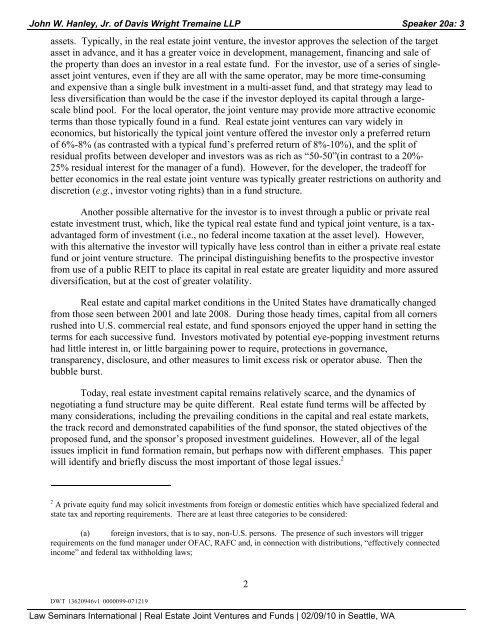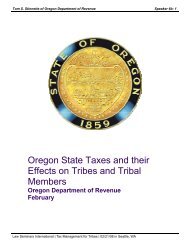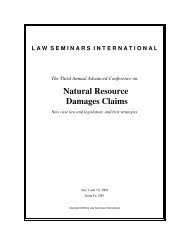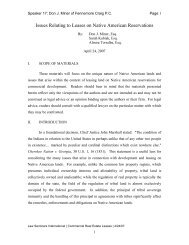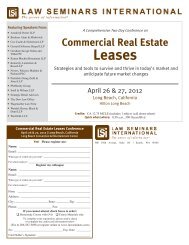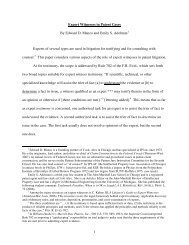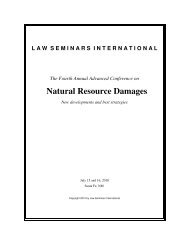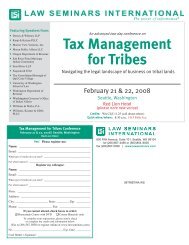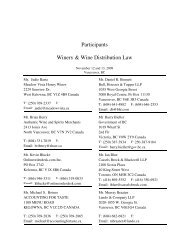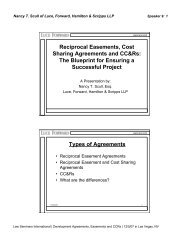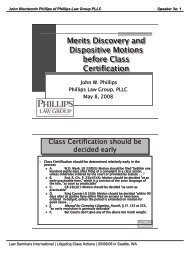LSI 2010 Real Estate Joint Ventures conference materials.pdf
LSI 2010 Real Estate Joint Ventures conference materials.pdf
LSI 2010 Real Estate Joint Ventures conference materials.pdf
Create successful ePaper yourself
Turn your PDF publications into a flip-book with our unique Google optimized e-Paper software.
John W. Hanley, Jr. of Davis Wright Tremaine LLP Speaker 20a: 3<br />
assets. Typically, in the real estate joint venture, the investor approves the selection of the target<br />
asset in advance, and it has a greater voice in development, management, financing and sale of<br />
the property than does an investor in a real estate fund. For the investor, use of a series of singleasset<br />
joint ventures, even if they are all with the same operator, may be more time-consuming<br />
and expensive than a single bulk investment in a multi-asset fund, and that strategy may lead to<br />
less diversification than would be the case if the investor deployed its capital through a largescale<br />
blind pool. For the local operator, the joint venture may provide more attractive economic<br />
terms than those typically found in a fund. <strong>Real</strong> estate joint ventures can vary widely in<br />
economics, but historically the typical joint venture offered the investor only a preferred return<br />
of 6%-8% (as contrasted with a typical fund’s preferred return of 8%-10%), and the split of<br />
residual profits between developer and investors was as rich as “50-50”(in contrast to a 20%-<br />
25% residual interest for the manager of a fund). However, for the developer, the tradeoff for<br />
better economics in the real estate joint venture was typically greater restrictions on authority and<br />
discretion (e.g., investor voting rights) than in a fund structure.<br />
Another possible alternative for the investor is to invest through a public or private real<br />
estate investment trust, which, like the typical real estate fund and typical joint venture, is a taxadvantaged<br />
form of investment (i.e., no federal income taxation at the asset level). However,<br />
with this alternative the investor will typically have less control than in either a private real estate<br />
fund or joint venture structure. The principal distinguishing benefits to the prospective investor<br />
from use of a public REIT to place its capital in real estate are greater liquidity and more assured<br />
diversification, but at the cost of greater volatility.<br />
<strong>Real</strong> estate and capital market conditions in the United States have dramatically changed<br />
from those seen between 2001 and late 2008. During those heady times, capital from all corners<br />
rushed into U.S. commercial real estate, and fund sponsors enjoyed the upper hand in setting the<br />
terms for each successive fund. Investors motivated by potential eye-popping investment returns<br />
had little interest in, or little bargaining power to require, protections in governance,<br />
transparency, disclosure, and other measures to limit excess risk or operator abuse. Then the<br />
bubble burst.<br />
Today, real estate investment capital remains relatively scarce, and the dynamics of<br />
negotiating a fund structure may be quite different. <strong>Real</strong> estate fund terms will be affected by<br />
many considerations, including the prevailing conditions in the capital and real estate markets,<br />
the track record and demonstrated capabilities of the fund sponsor, the stated objectives of the<br />
proposed fund, and the sponsor’s proposed investment guidelines. However, all of the legal<br />
issues implicit in fund formation remain, but perhaps now with different emphases. This paper<br />
will identify and briefly discuss the most important of those legal issues. 2<br />
2 A private equity fund may solicit investments from foreign or domestic entities which have specialized federal and<br />
state tax and reporting requirements. There are at least three categories to be considered:<br />
(a) foreign investors, that is to say, non-U.S. persons. The presence of such investors will trigger<br />
requirements on the fund manager under OFAC, RAFC and, in connection with distributions, “effectively connected<br />
income” and federal tax withholding laws;<br />
DWT 13620946v1 0000099-071219<br />
Law Seminars International | <strong>Real</strong> <strong>Estate</strong> <strong>Joint</strong> <strong>Ventures</strong> and Funds | 02/09/10 in Seattle, WA<br />
2


